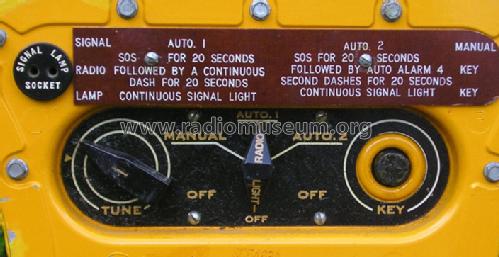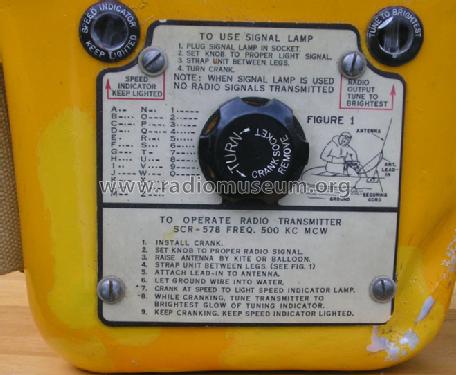SCR-578 BC-778
MILITARY U.S. (different makers for same model)
- Pays
- Etats-Unis
- Fabricant / Marque
- MILITARY U.S. (different makers for same model)
- Année
- 1942
- Catégorie
- Émetteur militaire
- Radiomuseum.org ID
- 105565
Cliquez sur la vignette du schéma pour le demander en tant que document gratuit.
- No. de tubes
- 2
- Principe général
- Émetteur
- Gammes d'ondes
- Bandes en notes
- Tension / type courant
- Solaire ou/et mécanique
- Haut-parleur
- - Pour casque ou amplificateur BF
- Matière
- Boitier métallique
- De Radiomuseum.org
- Modèle: SCR-578 BC-778 - MILITARY U.S. different makers
- Forme
- Modèle de table générique
- Dimensions (LHP)
- 265 x 265 x 215 mm / 10.4 x 10.4 x 8.5 inch
- Remarques
-
Radio transmitter of life-raft emergency set SCR-578 known as "Gibson Girl" for its ergonomic shape. Used by US Army Air Force. The transmitter was not crystal controlled. It consisted of an ECO RF oscillator-RF output valve 12A6, operating on 500 kHz, grid modulated by a 1000 Hz tone oscillator valve 12SC7. Equivalent to US Navy Model TCY. The SCR-578 is powered by a hand-cranked DC generator that is inside the case (note the crank on top of one of the photos).
See also T74-CRT3 which could also transmit on the aeronautical frequency of 8280 kHz.
- Source
- - - Data from my own collection
- Auteur
- Modèle crée par Ernst Rykkje. Voir les propositions de modification pour les contributeurs supplémentaires.
- D'autres Modèles
-
Vous pourrez trouver sous ce lien 398 modèles d'appareils, 350 avec des images et 210 avec des schémas.
Tous les appareils de MILITARY U.S. (different makers for same model)
Collections
Le modèle SCR-578 fait partie des collections des membres suivants.
Contributions du forum pour ce modèle: MILITARY U.S.: SCR-578 BC-778
Discussions: 2 | Publications: 3
Dieses Funkgerät wurde als eines von dreien, von Thor Heyerdahl auf seiner Kon-Tiki Expedition im Jahre 1947 benutzt. Im Kon-Tiki-Museum in Oslo kann man ein Exemplar besichtigen. Es handelt sich allerdings nicht um das Gerät welches auf der Expedition betrieben wurde.
Die von den Expeditionsfunkern benutzte Morsetaste und das Logbuch sind im Original ausgestellt.

Das im Kon-Tiki-Museum in Oslo ausgestellte Gerät
Uwe Rehage † 2015, 19.Aug.13
The life-raft emergency set SCR-578 contains a radio transmitter BC-778, called "Gibson Girl" for its shape. It was used in the WW2 by US-Amercan forces in case of an emergency. A guest, Jim Mandaville, has explained the following:
The "round thing" is a door which opens to expose a cylindrical chamber. Mounted on the back of the door is a reel with the antenna on it. The antenna is about 92 m long (only about one sixth wavelength at the operating wavelength of 600 m.) Some models also had a second frequency in the short wave range, either 8280 or 8364 kHz. This used the same antenna, which was then more efficient.
The antenna lead-in wire (about 1.5 m long) comes out from the back of the chamber. It has a spring clip on the end so you can attach it to the antenna. The antenna itself is raised at its far end by a kite or a hydrogen balloon (both of which are supplied in the original radio package).
The radio is operated in a sitting position, with the radio held vertically between one's upper legs, with the crank at the top. The straps go around the thighs to hold it firmly in place while the operator cranks. That is why the case has that "Gibson Girl" shape -- so it can be held more easily. It is quite a bit of work to operate the crank and maintain the minimum voltage (which is indicated by a light on the top of the case)!
It is rather amazing how the insides of the radio are kept waterproof through the use of gaskets at all case openings. When new, it could be thrown into the sea and would float and not leak, and still operate when taken out of the water.
This transmitter was a close copy of the German NS2 (Notsender Gerät 2). The British captured one of these from a crashed German plane and made a copy themselves. Another captured unit was sent to the U.S., where it was promptly copied in a somewhat different version. The whole idea was German and copied by G.B. and the U.S.
Thank you, Jim.
Ernst Erb, 05.Jan.11






